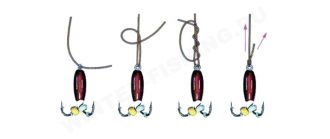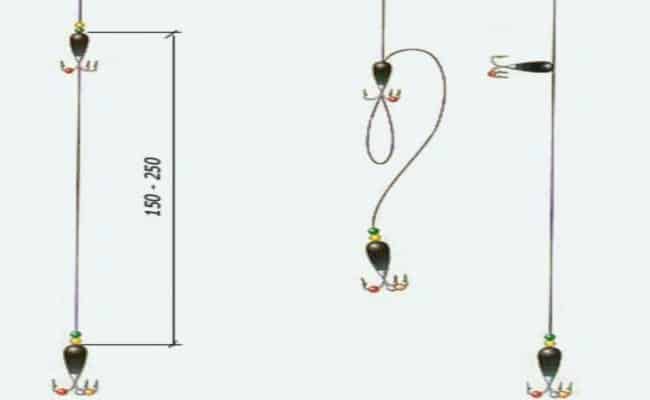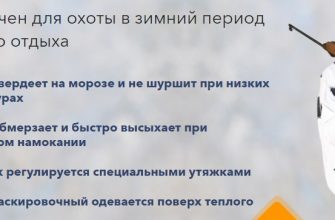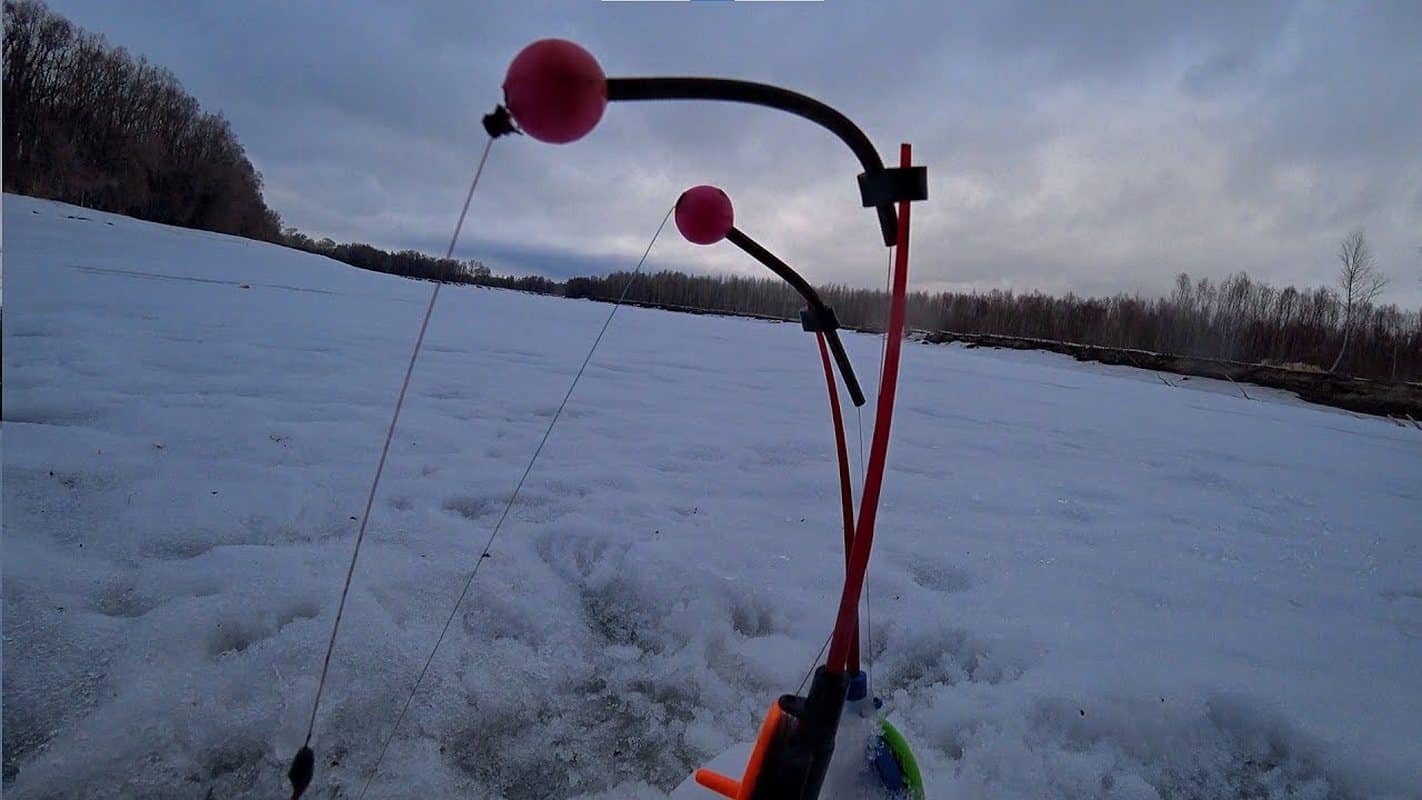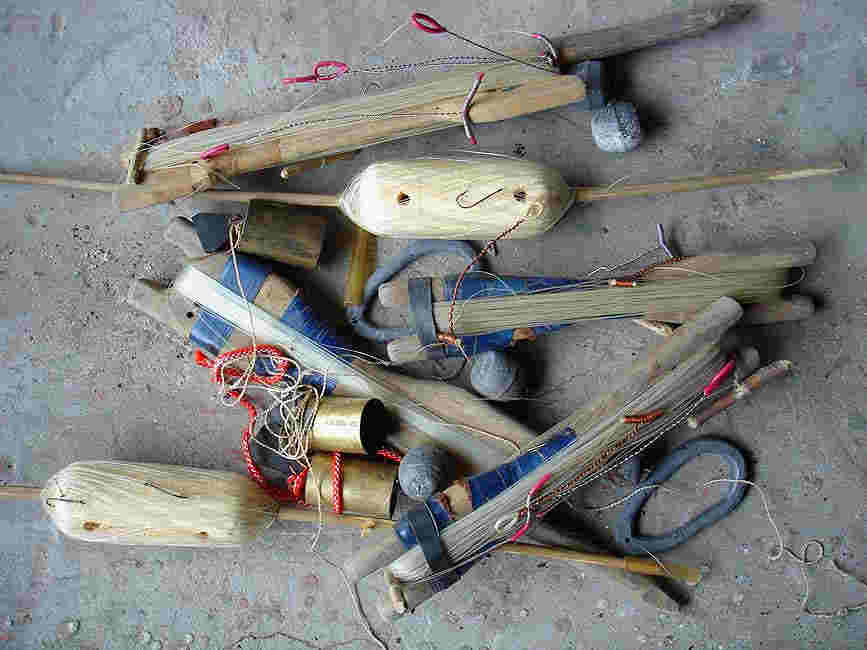One of the popular methods of no-hook (no-bottom) fishing in winter is the way of catching a “devil” (further without quotes, so as not to clog the air) – a jig with vertical suspension.
The devil (devil) is a jig for vertical suspension with 3-4 hooks bristling in all directions. The shape can vary from teardrop to elongated paunch. The first substantial mentions in Russian literature date back to the beginning of the 70s. That is, this type of winter fishing is almost half a century already … The two-hook model of a jig like a devil is called a goat and is not so popular.
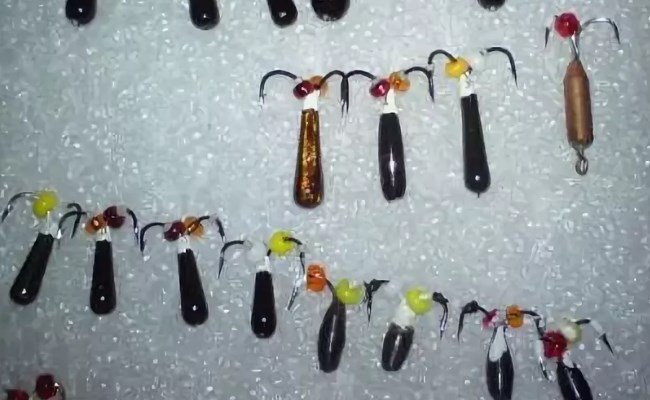
- Features of the jig, advantages and disadvantages of the nozzle
- Who goes to “hell” in winter
- How to choose a catchy little devil
- Classic – hard-welded tee, or three single hooks
- Loose tees
- Varieties of devils – jellyfish, goats and more
- How to make a devil’s jig with your own hands – inventing, preparing, casting
- Better to see once
- How to catch the devil in winter: techniques and tips
- Basic postings
- Standard – classic step
- Spruce wiring
- Dribbling in a given perspective horizon
- Tantalizing element – as an option for deafness and difficult conditions
- The devil is a bouncy
- Lazy even pull-downs
- Index finger animation
- We combine!
- Catching bream
- Catching perch
- Fishing for roach (sorogi), ide and chub
- Catching walleye
- Catching crucian carp
- Catchy devils Ukolov – photo and fishing from an expert
- We collect the tackle
- How to tie a rewinder jig: devil, goat, carnation and others
- Поделиться ссылкой:
Features of the jig, advantages and disadvantages of the nozzle
The devil especially manifests itself during the deafness, when the
balancers, the bastard and the spinners are silent. It is worth noting that the devil-less rewinder resembles a food base for peaceful and predatory fish – insects. At the same time, there is an opinion, and not unreasonable, that devils also serve simply as irritants for the pressed fish. This is especially evident in those cases when the fish does not respond to jig with booster, or a float rod. What is typical, on overfed reservoirs, it is the rewinder that often shows its best qualities – is not it proof of a double blow to the instincts of underwater inhabitants? Another plus is the almost perfect undercutting, due to the multidirectional hooks in the circle of the jig. Any angle of attack of the fish on the imp is doomed to the result. The disadvantages include the reverse side of the medal – in some situations the rewinder is inferior to fishing with a live bait. But it’s like this everywhere in lifesomewhere we find, somewhere we lose. It is also worth noting such a moment – in view of the fact that there are a large number of varieties of devils, and there are not so many catchy models, then it is difficult to choose the necessary one especially for a beginner. But if the arsenal is already assembled … It will be universal and under any conditions. One has only to select all the knots of success correctly: “the choice of the reservoir and the place of fishing, the choice of the right weather, the choice of the bait, the collection of the tackle, the supply of the bait.”the choice of the reservoir and the place of fishing, the choice of the right weather, the choice of the bait, the collection of the tackle, the supply of the bait. “the choice of the reservoir and the place of fishing, the choice of the right weather, the choice of the bait, the collection of the tackle, the supply of the bait. ”
Who goes to “hell” in winter
On the devil, you can catch both peaceful and predatory fish, which is also the advantage of devils. Main clients:
- perch;
- chub;
- ide;
- roach;
- top water;
- bream, bream;
- ruff.
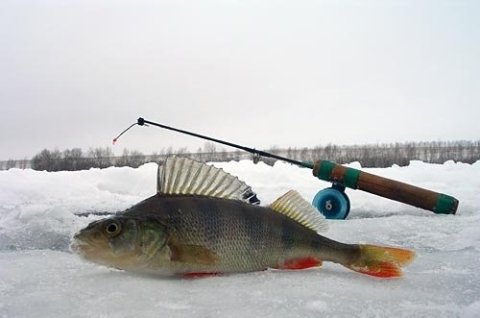
How to choose a catchy little devil
There will be no ratings here. It is more important to choose the necessary rewinder for specific fishing conditions. One and the same model will perform better in some conditions, and worse in others. In the second jig, on the contrary. Also, the catchability directly depends on whether the angler has found a common language with one or another bait. Someone that will fall into the hand. You need to experiment and have a set in your arsenal for a variety of conditions. Let’s go through the main categories of devils.
Classic – hard-welded tee, or three single hooks
The main species, which is an apologist for devil fishing. The shape of the body is very different – a drop, an olive, a cone, a trapezoid, an “ant”, etc. It is good that the box contains different shapes, weights and materials.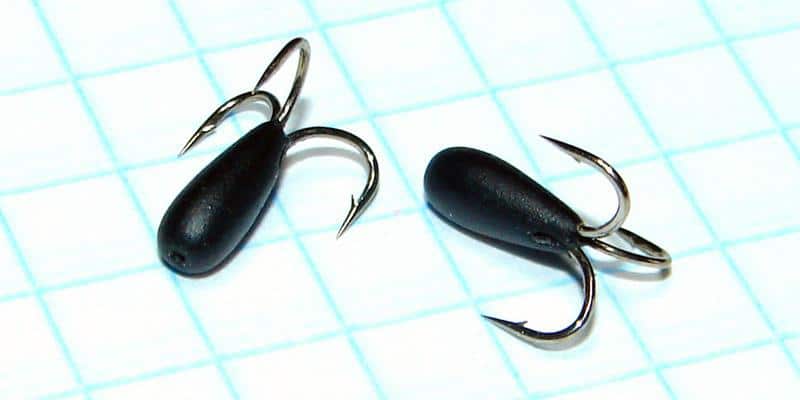
Loose tees
Another variety is devils with free hooks. On the one hand, this gives a more attractive game, but also more chaotic. Therefore, the choice for a rigidly and freely fixed anchor must be made based on the conditions.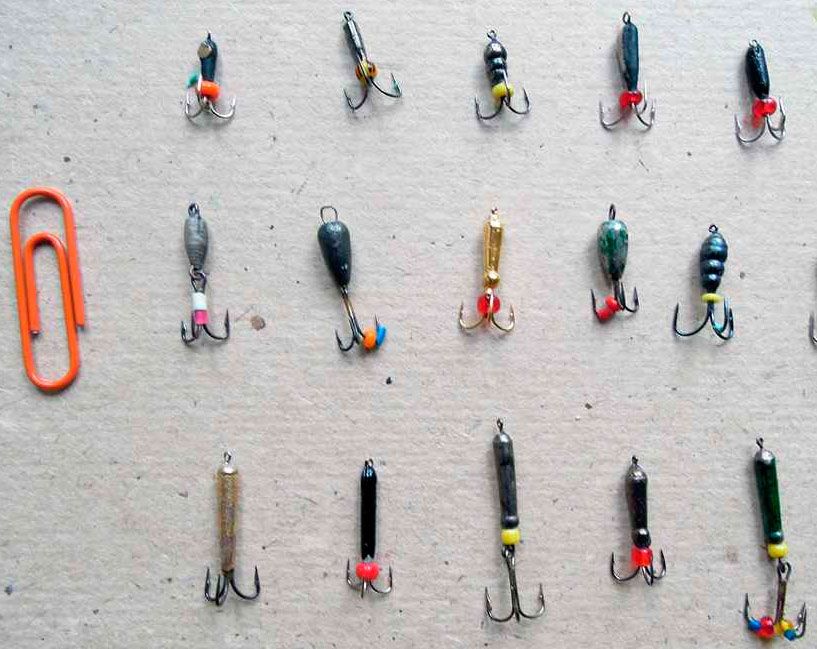
Varieties of devils – jellyfish, goats and more
Jellyfish is a kind of a devil with hooks around the body, which are fixed with a wire ring: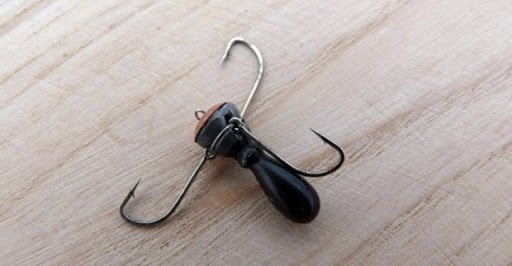
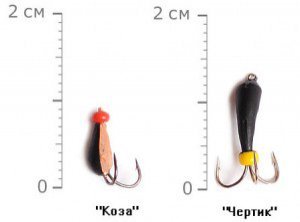
How to make a devil’s jig with your own hands – inventing, preparing, casting
There are a lot of options for making rewinder with your own hands. The base / body can be made of sheet lead, wire, pellets and other materials at hand. As hooks – either tees, or single hooks, depending on the technology. As an additional point of attack, you can put on beads or cambric on the tees. To shape the body and its beauty, epoxy glue, resin, gel polish can be used. Loops, when making devils with your own hands, can and should be made in different shapes and bend at different angles to the body of the jig. This will help to diversify the game and give additional opportunities to the angler when animating the jig.
Better to see once
How to make a mormyshka a devil with your own hands: https://youtu.be/zyk4hoUmNiQ How to make devils for winter fishing for fishing with a garland: https://youtu.be/82eqFfcCY-g Another option: https://youtu.be/ uZ-EyolugGE
How to catch the devil in winter: techniques and tips
The holes are drilled in a standard way. Promising places are selected and holes are drilled in a checkerboard pattern every 8-12 meters. The first saber is up to 15-20 holes. Fishing begins from the first hole, which has already rested. If the point for fishing is chosen correctly, then there are three components of success – a correctly chosen devil, a correctly tuned tackle and a feed (read wiring) rewinder. This section is about transactions and secrets. The posting of a soapless jig is more important than jigs of edged yummy in the form of a bloodworm and other live bait. It is understandable – the bloodworm praises itself. Before sending to the pond and on the pond itself, it is worth paying attention to the following factors, which in one way or another affect the quality of fishing and ultimate success:
- Atmosphere pressure;
- precipitation or lack thereof;
- temperature of water and air;
- Direction of the wind;
- ice – thickness, transparency;
- bottom – composition, clutter;
- what insects are present in the reservoir – a direct indication of which devil to pick up;
- correctly selected tackle;
- selection of the necessary devil and the approach to its animation.
Basic postings
The only correct wiring of the devil is not and cannot be. In different conditions (body of water, type of fish, depth, atmospheric conditions, etc.), different types of animation will be good. But the prompt selection of the very recipe for specific fishing conditions is the basis of success, the basis of which is the experience of the fisherman. Also, do not forget that the animation style of the bait, like the bait itself, must go, as they say, “into the hand”, to match the character of the fisherman, his vision of fishing in general.
Practical fact. A fisherman, albeit a less experienced one, but who has thoroughly studied a particular water body and the habits of its inhabitants, will always catch a more experienced “devil’s pen”, but who has first found himself in new conditions. There is no point in catching perch where there is a raft or bream, be it a spoon or a devil.
But it will not be superfluous to study the base of rewinder animation (why reinvent the wheel in the 21st century), especially for novice devils.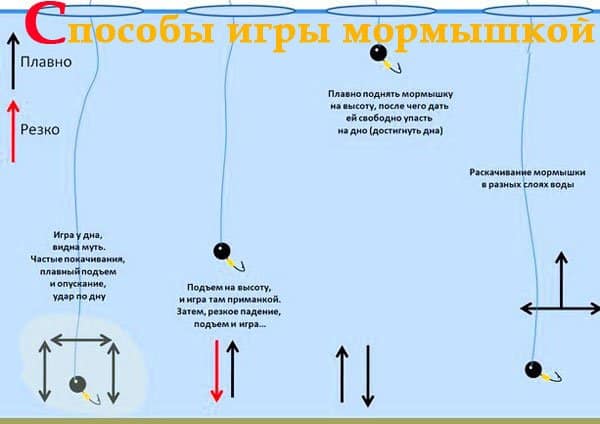
Standard – classic step
The most common wiring among others. Its advantage is versatility and working qualities for different fish. The imp sinks to the bottom of the hole, a pause is given before playing a nod to a strictly horizontal position. The overhang of the line is noticed. Further, by translational movements, the rewinder rises stepwise to the surface. This is clearly seen by the nod – the devil seems to be thrown by smooth movements of the fishing rod from step to step.
The step size between the steps can vary from 1-2 cm to 10-15 cm. It all depends on how aggressive the wiring is required. For example, slow dribbling is good for a perch, the more chaotic the better. And the roach prefers short steps of 5-7 cm with pauses.
Pauses between tossjigs from step to step can vary from practically absent to quite significant up to 5-10 seconds or more. The more active the fish, the less the pause – in general, this is the animation that works.
The rate of the devil’s ascent also differs from the lazy, imposing one for bream, crucian carp, to fast posting for perch and pike perch. You can add dribbling elements to the wiring
– constant twitching of the bezel throughout the execution of the steps. It is especially effective to catch perch on the devil with such a posting. The height of the entire ladder is selected empirically and depends on which horizon the fish is in. At the beginning and end of winter, you need to break through the entire horizon, often peaceful fish graze in the floor of the water and you should not limit yourself to the bottom layer of the reservoir. But in the wilderness, most often fish should be looked for at the bottom and half a meter away from it. In any case, initially you need to look for fish along the entire vertical and only after finding it, then do the active phase of the posting in the working fish horizon.
Spruce wiring
“Christmas tree” – one of the options for stepped wiring, in which the movements of the rod are not made strictly vertically, but to the sides, as if cutting the characteristic teeth of the drawn Christmas tree with multidirectional waves. All other components echo the stepped wiring. More often, such wiring is used when planting a bloodworm on a jig, but it is also used in a rewinder. The devils use this animation for the perch. The rod is held at some angle down to the horizon 30-45 degrees.
Dribbling in a given perspective horizon
If with the help of the “fir-tree” or “step” the working horizon of the position of the fish has been clarified, then it is possible to fish only it within the range of 30-50 cm, having previously marked it with the help of a cambric on the line, or by noticing it with the help of the overhang length. The wiring consists in shaking with one amplitude or another with the help of short pulls with a rod. Some anglers ask such a game by small and quick tapping of the left hand on the fishing rod, while the vertical movement of the jig is set by the right.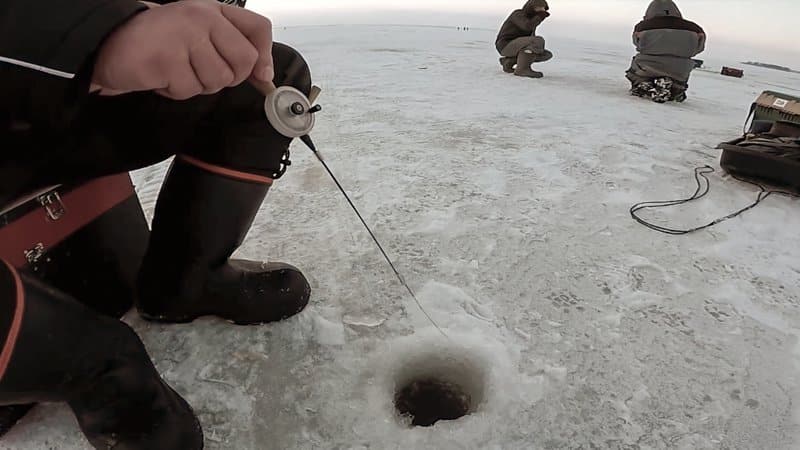
Tantalizing element – as an option for deafness and difficult conditions
In the case when the fish is passive and squeezes to the bottom, you can use the devil’s pulls along the bottom, practically without breaking away from him. All wiring takes place in a horizontal plane, and the nod is bent, then unbent, slowly trembling.
The devil is a bouncy
The rewinder sinks to the bottom, after which the fisherman taps the bottom with point detonations with further return of the fishing line. Thus, the devil just actively jumps along the bottom, raising a small cloud of turbidity. A very good option for active fish and in the form of an intermediate type of animation, if the fish does not respond to the main postings.
Lazy even pull-downs
Slow stretching without jerking with a pause at the final dead center, after which the devil begins to crumble, is used when fishing for bream and bream, large roach, rudd and other cautious peaceful fish. It is important that the detachment of the rewinder from the bottom is as smooth and uniform as possible without parasitic vibrations of the jig on the rise.
Index finger animation
In this case, the rod is held with the palm of the hand so that the index finger rests on top of the whip. Guiding is carried out vertically evenly, and the rattling is set by strokes of the finger on the whip. The blows can be both throughout the entire posting, and at certain moments – on pauses, rise, fall of the devil.
We combine!
In any incomprehensible situation, we experiment with combinations of different ways of feeding the rewinder. Correctly selected wiring is the key to success. It is important to change the animation speed, the sharpness of the pulls, the amplitude and frequency of the jitter, the height of the steps on the staircase, the dimension and length of the pauses. It is also very important to look for fish in different horizons. We punch with segments (bottom-20 cm), (20 cm – 50 cm from the bottom), (50 cm – a meter above the bottom).
Worth knowing! What to do if the fish stops responding to the bait in the hole where it just pecked? It is worth noting that after a long variety of different types of posting in one hole, the fish can “get tired” and stop reacting even to the most delicious serving of a devil. In such a situation, it is either worth giving the hole a rest, or laying the jig to the bottom and giving a pause without slightly moving the bait, or with minimal movement. In general, it should be noted that it is not worth “torturing” one hole for a long time. Ten to one and a half different types of animation of a devil in one hole, it is worth moving to the next, previously prepared hole.
Video on the topic of catching the devil in the dead of winter – a master class from a professional: https://youtu.be/3aBDcZrVODI
Catching bream
The devil sinks in a promising “bream” place to the bottom, playing back a nod when the rewinder hits the bottom. Since the bream often does not stand at the very bottom, but at some distance from it or even in the water column, a long vertical line with a not sharp animation like “herringbone” right up to the floor of the water will be promising. Bream loves slow, imposing driving of the devil, especially reversible controlled falls. It is also worth using pauses and rather long pauses with stepped wiring. Good for bream devils with free hanging hooks on the slowest wires at the bottom. Catching bream for a devil: https://youtu.be/oVPXF4UYRIk Bream can be caught at night, which suggests that the behavior of the rewinder is more important than its appearance.And the behavior directly depends on the ability of the angler to correctly (from the point of view of the fish) animate the demon. It is worth noting that when fishing for a devil, especially a bream, the hook should be quite fast, but not long, otherwise you can break off a thin tackle or a delicate lip. And that and that option, as you might guess, is not the best option.
Catching perch
The perch prefers a rather quick rattling of the devil, combined with an average rate of rise of the bait to the surface. Stripes rarely respond to sluggish play, more often give them sharp and chaotic jerks. Among the colors he prefers black and yellow.
Fishing for roach (sorogi), ide and chub
This trio of fish prefers smoother drives. Among the workers there is a slow and medium step at the bottom and half way, a Christmas tree without sharp jerks. The animation of this kind is also good – the devil rises by steps by 40-60 centimeters. Then, in a controlled manner, it drops by 20 centimeters and 3-4 light jerks are made, still drops by 20 cm and more jerks, and so on to the very bottom. Then the steps are repeated. Winter fishing on the line of Ukolov of large roach: https://youtu.be/vRkavkMuT1s
Catching walleye
The pike perch prefers large rewind heads and postings at the bottom. A step, a Christmas tree, various combined animations with pauses of rises and falls. https://youtu.be/oYUR0HAJais
Catching crucian carp
When fishing for crucian carp with a rewinder, the devil should prefer posting options, the execution of which is possible in the water column.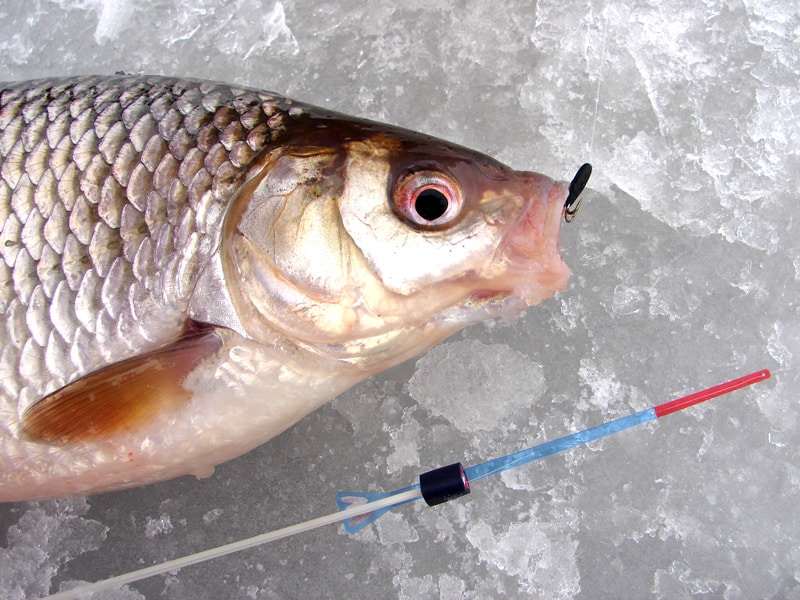
Catchy devils Ukolov – photo and fishing from an expert
Very popular among domestic fishermen are Ukolov’s devils in a 1-2 gram chart: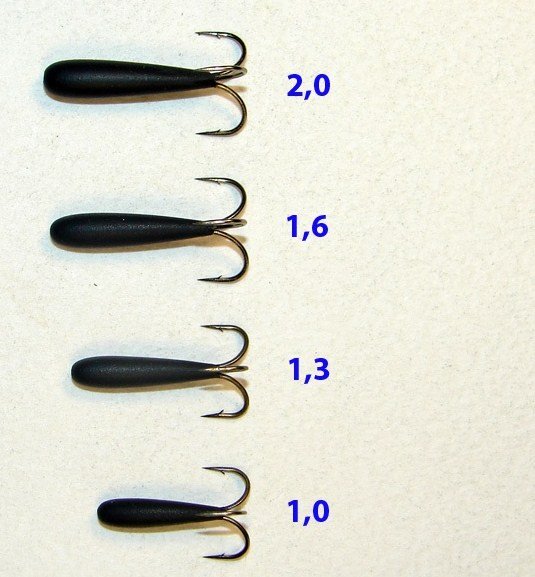
We collect the tackle
Balalaika is the most popular fishing rod when fishing with reelless jigs. It is lightweight, fits well in the hand and is very sensitive. It is these qualities that make it possible to perform various animations throughout the day comfortably and effectively. A fishing rod must necessarily be with a reel and have a low weight – the balalaika is exactly about that.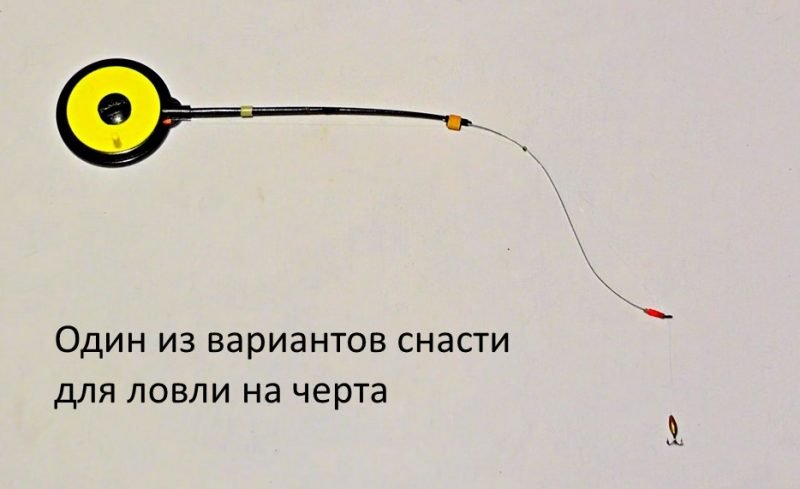
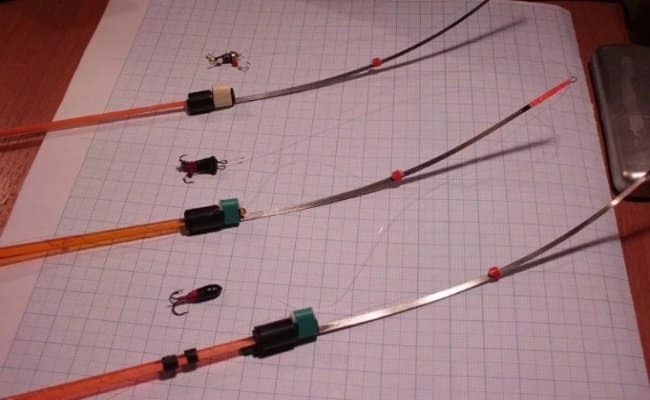

How to tie a rewinder jig: devil, goat, carnation and others
The simplest and standard option for tying a devil to a fishing line: